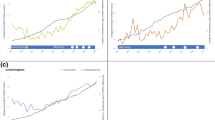Abstract
Document cocitation analysis, as developed by Small and Griffith, was employed as a means of assessing current Dutch participation in science. The method compared overall Dutch published contributions to science (1–2%) with the percentage of Dutch papers in both the cited “cores” of clusters and the citing “margins” of clusters (newly published papers). It was possible to identify clusters ranging form ones with strong Dutch participation to those without Dutch cited or citing papers. The method may help policymakers to detect areas of special concern. The technique can be used for any nation, but may be particularly helpful for the smaller developed countries. We consider the ideal distribution of scientific productivity for those countries.
Similar content being viewed by others
References
National Science Board (NSF):Science Indicators 19xy; Government Printing Office, Washington D. C.
RAWB: Wetenschaps- en technologie-indicatoren: Een vergelijking van Nederland met buitenland op basis van kwantitatieve gegevens; Achtergrondstudies RAWB Nr, 11, Den Haag, 1984.
Database produced by the Institute for Scientific Information, Inc. Philadelphia, best known as publisher of theScience Citation Index (SCI).
E. GARFIELDCitation Indexing Chap. 8; John Wiley & Sons, New York, 1979.
E. GARFIELD, M. W. MALIN, H. SMALL, Chap. 8,Citation Data as Science Indicators; Toward a Metric of Science, Y. ELKANA et al. Ed.; John Wiley & Sons, New York, 1978.
E. GARFIELD, I. SHER, R. J. TORPIE: The Use of Citation Data in Writing the History of Science; ISI, Philadelphia, 1964.
D. J. DE SOLLA PRICE, Networks of Scientific PapersScience 149 (1967) 510–5.
I. V. MARSHAKOVA,Nauchno Tekhnicheskaya Informatsiya Seriya, 2 (1973) 3–8.
H. G. SMALL, Co-citation in the Scientific Literature: A New Measure of the Relationship Between Two DocumentsJ. Am. Soc. Inform. Sci. 24 (1973) 265–9.
H. G. SMALL, B. C. GRIFFITH, The Structure of Scientific Literature, I: Identifying and Graphing Specialties,Science Studies, 4 (1974) 17–40.
B. C. GRIFFITH, H. G. SMALL, J. A. STONEHILL, S. DEY, The Structure of Scientific Literature, II: Toward a Macro- and a Micro-structure for Science,Science Studies 4 (1974) 339–65.
G. SALTON, D. BERGMARK, The Citation Study of Computer Science Literature;IEEE Transactions on Professional Communications pc-22, No. 3, (1979) 146–158.
D. J. DE SOLLA PRICE: Private communication, quoted in in perhaps not his own words. He told of many other occasions and people, he had given similar advise.
Author information
Authors and Affiliations
Rights and permissions
About this article
Cite this article
Mombers, C., Van Heeringen, A., Van Venetië, R. et al. Displaying strengths and weaknesses in national R&D performance through document cocitation. Scientometrics 7, 341–355 (1985). https://doi.org/10.1007/BF02017153
Received:
Issue Date:
DOI: https://doi.org/10.1007/BF02017153




